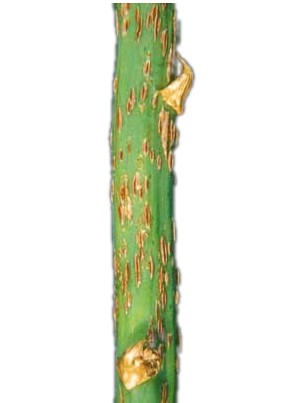Asparagus Rust
 Causal Agent
Causal Agent
The fungus Puccinia asparagi
Hosts
Asparagus
Symptoms
Rust appears first as raised, green spots (pustules) on stems and branches of developing ferns. Spores from these pustules reinfect ferns and produce brick-red pustules on stems and branches. A different spore type from these brick-red pustules also reinfects ferns and results in increased rust pressure. Rust is easily identified at this stage by observing the rust-colored powdery mass of spores released from these pustules when rubbed against white paper or light-colored clothing. These red pustules turn black in color as the spots age. The black color is a result of the formation of dark-colored resting spores which overwinter and are capable of initiating the disease the following year. Conditions that favor rust development are periods of prolonged heavy dew formation and dry soil. Damage caused by rust is a result of reduced crown vigor when plants are infected several years in succession. Severe infection over several years will greatly weaken crowns to the extent that yield is reduced.
Control
The best control measure is to plant rust-resistant varieties. Most of the newer hybrid varieties are rust resistant. If a susceptible variety is used, rows should be spaced six feet apart and oriented in a north-south direction to maximize air movement and drying down the rows. During harvest, cut all spears, fern growth and non-harvested plants to ground level or below. This will aid in breaking the disease cycle and may halt rust development. If rust appears on ferns after harvest, the fungicide spray schedule recommended for management of Cercospora blight will also provide rust control. Please contact your local county extension office for current information.

